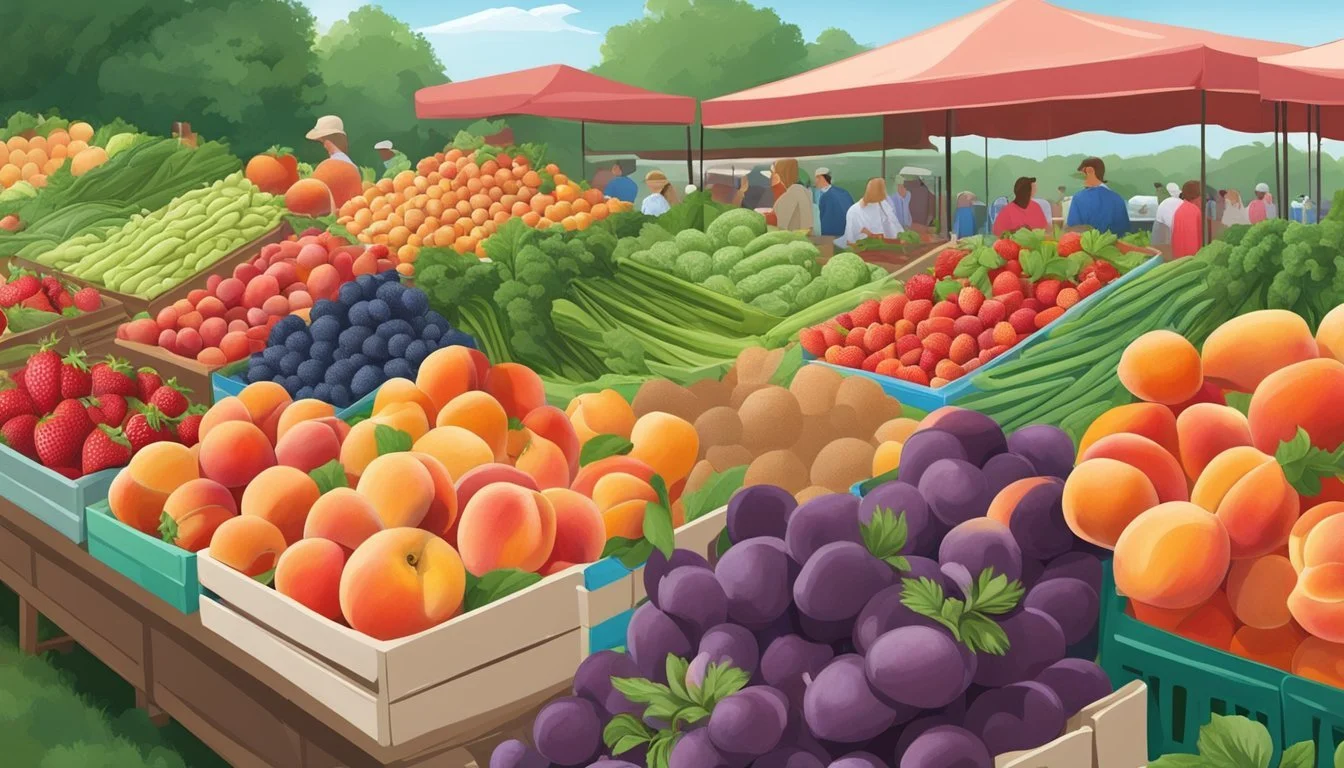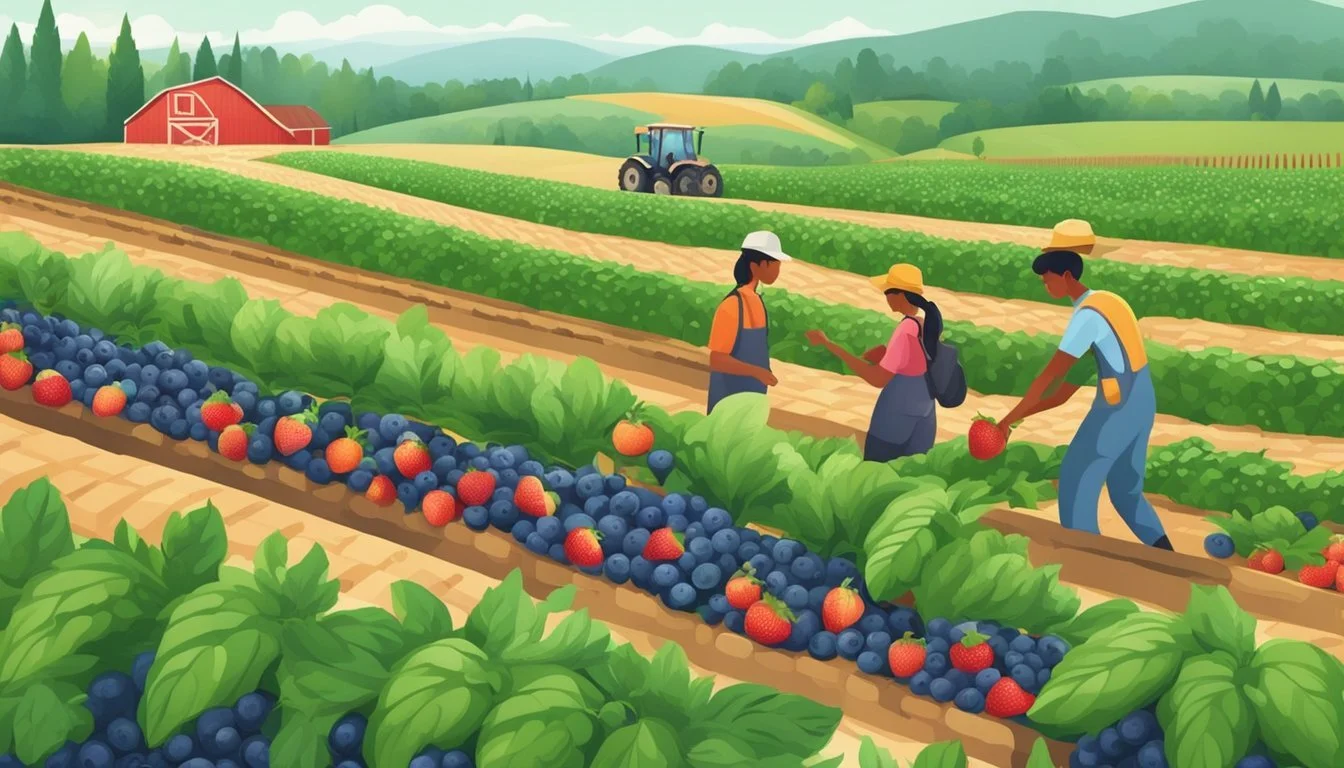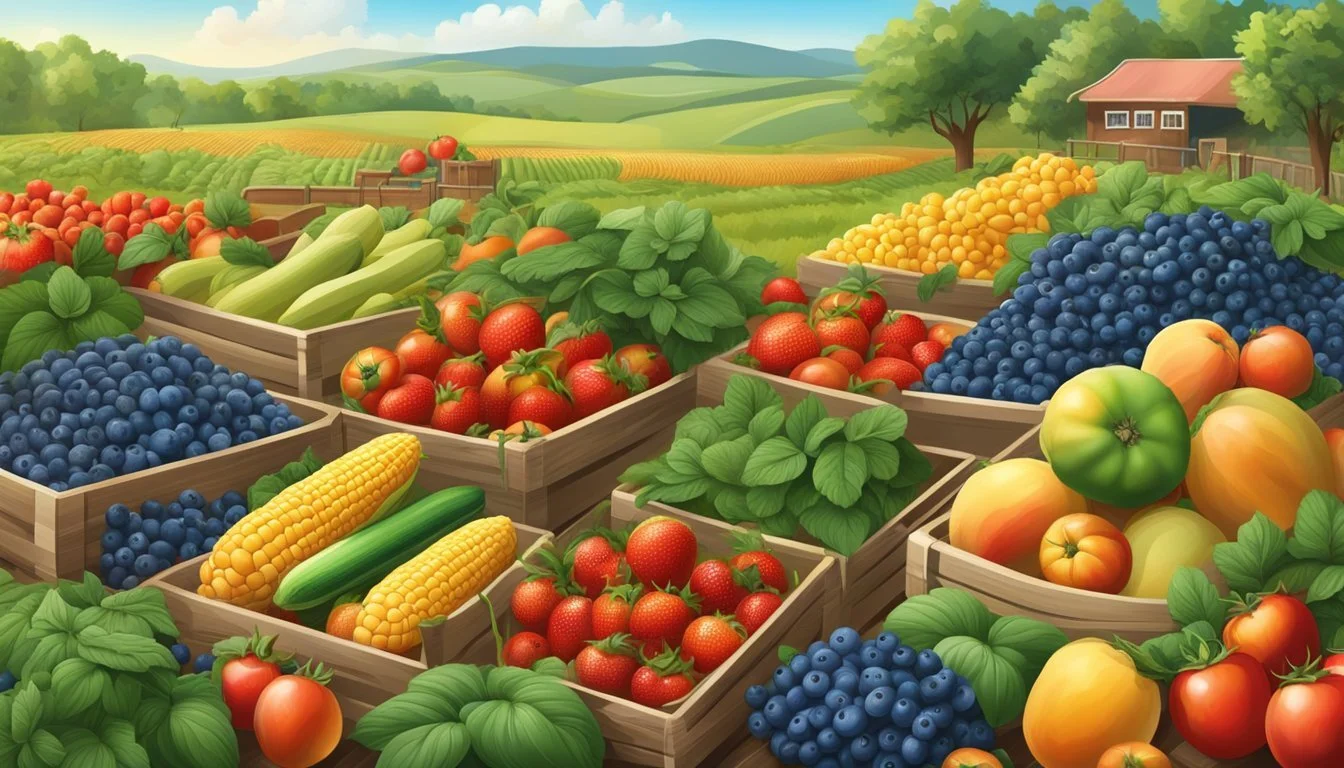Georgia Seasonal Fruit & Vegetables in May
A Guide to Fresh Produce
This Article is Part of our Georgia Seasonal Fruit & Veg Calendar
Georgia’s climate offers a rich and diverse canvas for agricultural bounty, and as spring deepens into May, the state's farms burst with fresh produce. This period is a pinnacle of growth where the temperate patterns provide an ideal environment for a wide array of fruits and vegetables. Local markets and farm stands begin to showcase the season’s harvest, reflecting the state's agricultural rhythm and the transition from spring’s tender offerings to the more robust flavors of approaching summer.
In May, Georgia's soil becomes a tapestry of colorful and nutritious fruits and vegetables. Hearty greens like collards thrive alongside the sweetness of berries and the earthiness of root vegetables. The state's agricultural zones each contribute their specialties to the cornucopia. From the Blue Ridge Mountains to the coastal plains, consumers and chefs alike eagerly anticipate the arrival of fresh, Georgia-grown produce, which not only supports the local economy but also ensures a level of freshness that can be tasted in every bite.
Health-conscious individuals and culinary enthusiasts rejoice in May as they have access to an abundance of fresh produce. Blackberries and blueberries (how long do blueberries last?) offer antioxidant-rich options for both direct consumption and delightful recipes. Meanwhile, the fields yield a versatile selection of vegetables including broccoli (how long does broccoli last?), cabbage, carrots, and kale, along with the first succulent peaches of the year, signaling the beginning of the eagerly-awaited stone fruit season in Georgia.
Seasonal Availability
May in Georgia offers a bountiful selection of fresh fruits and vegetables that are at their peak, thanks to the region's conducive climate and weather conditions.
Fruit:
Strawberries: Boldly enter their prime in May, providing a juicy, sweet taste.
Blueberries: Start to become available, promising bursts of flavor.
Vegetables:
Tomatoes: Ripe and ready, they offer versatility in dishes from salads to sauces.
Sweet Corn: (how long do cucumbers last?) Comes into season, ideal for grilling or boiling.
Cucumbers: Begin to flourish, perfect for refreshing salads.
Zucchini: Offers its mild, earthy essence to a variety of dishes.
Green Beans: They start to peak, adding a crisp texture to meals.
In Georgia, May's warmer temperatures and adequate rainfall create an ideal environment for these fruits and vegetables to thrive. Data-wise, this period signifies the start of a vibrant harvest season.
Leafy Greens:
Kale: Deep green hues signal its readiness.
Collards: Stand out for their hearty leaves, often used in Southern cooking.
Lettuce: Springs up in an array of varieties, each contributing a unique texture and taste to salads.
The collection of seasonal produce available in this month reflects a transition from spring to summer, which is visible in the vibrant colors and varied flavors of the produce.
Fruit Highlights
May is a transformative month in Georgia, with a variety of fruits coming into season that offer an array of flavors and health benefits. Residents and visitors alike can enjoy the freshest, tastiest, and most nutritious produce direct from local farms and orchards.
Berries in Bloom
In May, strawberries are at their peak, offering a sweet and succulent taste that is perfect for both fresh eating and desserts. Blackberries also start to make an appearance, with their rich, tart flavor and high antioxidant content.
Stone Fruit Beginnings
Peaches, the iconic fruit of Georgia, begin their season in May. Although they'll continue to ripen over the summer, early varieties are available, providing a juicy and fragrant component to the state's fruit offerings. Additionally, while not as prevalent, some early cherries (how long do cherries last?) may be found at local markets, signaling the start of their season.
Late Spring Surprises
Blueberries, another powerhouse in the nutritional lineup, come into season in May. They are packed with vitamins and can be found fresh off the bush in this month, making them a perfect snack or addition to morning cereals and pancakes.
Sustaining Nut Production
While not traditionally seen as a fruit, pecans (how long do pecans last?) fall under the category of drupes, similar to peaches and cherries. In May, these nuts (how long do nuts last?) continue to be available from the previous season's harvest. They bring a rich, buttery flavor and are often used in baking or as a protein-rich snack.
Vegetable Insights
May in Georgia is a transitioning period where an abundance of vegetables begin to burst into the market. Gardeners and consumers alike can expect a variety featuring leafy greens, early summer crops, and an array of root vegetables.
Leafy Greens Galore
Georgia's May climate nurtures a variety of leafy greens. Kale, lettuce, and spinach are in full swing, offering a bounty of nutrients and flavors. They are typically harvested before the summer heat intensifies, ensuring tender leaves and the best quality.
Kale: Robust and nutrient-rich, ideal for salads and cooking.
Lettuce: A multitude of varieties are at their peak crispness.
Spinach: Known for its versatility, spinach can be used fresh or cooked.
Roots and Shoots
Root vegetables like carrots and potatoes are harvested in May. They offer earthy flavors and are incredibly versatile in the kitchen. Asparagus (What wine goes well with asparagus?) spears continue to shoot up and are readily available, marking the tail end of their season.
Carrots: Sweet and crunchy, perfect for raw snacks or as a cooked side.
Potatoes: A staple with a variety of types ready for digging up.
Asparagus: Fresh asparagus can be found, with its tender stalks ideal for quick cooking.
Summer Previews
While not in full season until the warmer months, some early varieties of tomatoes, cucumbers, and peppers start to make an appearance in May. These vegetables offer a preview of the summer's upcoming agricultural richness.
Tomatoes: Young and often greenhouse-grown, with a refreshing taste.
Cucumbers: Crisp and hydrating, starting to come into season.
Peppers: Early varieties begin to emerge, hinting at the diverse summer selection to come.
Season Extenders
The use of greenhouses and other season-extending techniques allows some warm-weather crops like corn, broccoli, and cabbage to be accessible before their traditional outdoor growing season.
Corn: It can be found early due to controlled cultivation methods.
Broccoli: Georgia's soils allow for early broccoli that is flavorful and tender.
Cabbage: Versatile and ready for harvest, it can be both eaten raw or cooked.
Market Trends
In May, Georgia's market trends reflect the shift in supply and demand as the state enters its prime growing season. Both farmers markets and supermarkets adapt their selections, while wholesale dynamics change with the availability of seasonal produce.
Farmers Market Finds
At farmers markets throughout Georgia, May heralds an abundance of fresh produce. Tomatoes become a common sight, with many varieties ranging from heirlooms to cherries available in abundance. Shoppers will also find a myriad of berries, including strawberries and blueberries, as their season peaks. Georgia's cherished peaches begin to make an appearance, leading to excitement and increased market traffic.
Tomatoes: Wide variety, strong demand, moderate prices
Berries: High supply, especially strawberries and blueberries
Peaches: Early season varieties start to surface
Supermarket Selections
Supermarkets stock up on Georgia-grown produce, catering to customers' preference for local and fresh. Cucumbers and tomatoes are typically sourced in larger quantities to meet the steady customer demand. Although supermarket prices for berries reflect their widespread availability, the quality and freshness are best at farmers markets.
Cucumbers: High stock levels, competitively priced
Tomatoes: Good availability, promotional deals common
Berries: Market standard quality, price varies by type
Wholesale Dynamics
Wholesalers play a critical role in the food supply chain by managing bulk purchases and distribution to retailers. In May, wholesalers observe a significant increase in volume for local peaches, cucumbers, and tomatoes. This bolsters the supply side, affecting price trends for smaller retailers and impacting the overall market dynamics.
Peaches: Increased wholesale volume as harvest begins
Cucumbers and Tomatoes: Stable supply, competitive wholesale pricing
Market: Adapting to shifts in local produce availability
The agricultural richness of Georgia shines in May, and the market trends shift accordingly to showcase some of the state's best seasonal offerings.
Agricultural Practices
In Georgia, the month of May marks a significant time for farmers focusing on both fruit and vegetable cultivation. These agricultural practices are underpinned by a strategic approach to water management, the implementation of varied farming techniques, and a commitment to sustainability.
Farmers utilize drip irrigation and sprinkler systems to ensure efficient water use, vital for crops during this growing season. Drip irrigation targets the root zones directly, reducing water waste, while sprinklers can be used for broader applications when necessary. Both methods support plant health by providing consistent moisture, which is particularly important given that May can be a dry month in some parts of Georgia.
Farming techniques adapt to the type of crop being cultivated. For fruit trees and vines such as peaches and muscadines, practices like pruning, thinning, and trellising optimize sunlight exposure and air circulation. These techniques not only boost yield but also improve fruit quality. For vegetables like tomatoes and eggplant that peak in May's warmth, staking and the use of raised beds are common to enhance growth and prevent disease.
Sustainability remains a core principle, with farmers employing crop rotation and cover cropping to maintain soil health. These practices reduce pest pressure and build soil fertility without relying solely on chemical fertilizers.
Crop Rotation: Alternating crops to prevent depletion of specific soil nutrients
Cover Cropping: Planting of grasses or legumes during off-seasons to protect and enrich the soil
The adoption of integrated pest management (IPM) techniques further reflects sustainable efforts, minimizing chemical use by relying on biological and physical controls to manage pests. Georgia's farmers aim for a balance between high-quality produce and environmental stewardship, ensuring that agricultural output is not only plentiful but also sustainable.
Looking Forward
As May flowers signal the approach of summer, Georgia’s farms prepare for the shift in produce and climate. Consumers eagerly await the fresh flavors June will bring.
Next Month's Produce
June marks the beginning of summer's bounty in Georgia. The state's farms are ready to harvest a variety of fruits and vegetables. Here is what consumers can look forward to:
Vegetables:
Tomatoes
Cucumbers
Squash
Green Beans
Sweet Corn
Fruits:
Peaches
Blueberries
Blackberries
Each of these crops thrives in the warm June weather and will be at peak freshness.
Anticipating Weather Changes
The transition from May to June in Georgia brings a marked change in climate, which directly influences agricultural patterns. Farmers must remain alert to:
Temperature Increase: Average daily temperatures rise, ideal for heat-loving crops like tomatoes and watermelon.
Rainfall Patterns: The onset of summer can see varied rainfall, from short downpours to dry spells, impacting irrigation needs.







